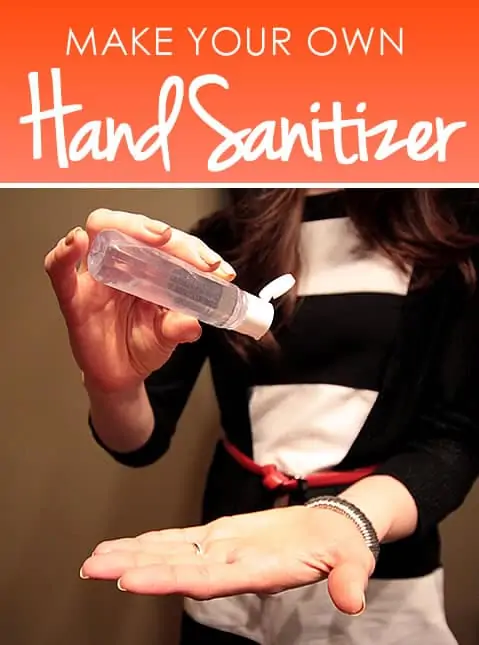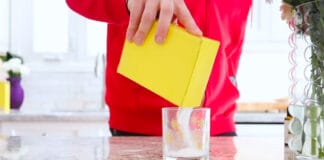Full disclosure, I’m not a fan of hand sanitizer because I much prefer good old fashioned handwashing with soap and water. I feel it’s cleaner, I can’t explain it, but I do. However, at times, I can’t access ‘old reliable’ and hope to goodness I don’t accidentally touch my face or eat with my fingers (me? never!). That’s when hand sanitizer comes in handy. However, I have a three-fold issue with traditional, store-bought hand sanitizers.
First, I detest (thumbs down, dislike, unfollow, unsubscribe, you get the idea) the smell. It’s antiseptic mixed with pseudo-sweet, sciency fruity floral, yuck! I have yet to find one that I can handle, plus, the scent lingers forever and that affects my palate if I am eating. On the other hand (no pun intended), my husband loves it. Oh, the things I put up with!
Second, they are really drying, especially in cold weather—take it from a Canuck!
And finally, they contain Triclosan—a hotly debated topic (more about this later).
Bug Off
Not a news flash, creating resistance to bugs by using strong sanitizers constantly will only harm us in the long run. Consistent use of a product like this will make your immune system lazy and that’s something you want to protect and cultivate, not weaken. Remember, your body (the fascinating mechanism that it is) has a built-in function to do this for you.
So Why the Hype?
Of the research I’ve done (sorting through both facts and many ‘blog posts’), the recipe that spoke to me (and that I share here) was the one created by a chemist on About.com who has an inherent, intimate understanding of the workings of chemicals and their interactions with humans. Her and I share the same vision for hygiene: regular handwashing with soap and water that is the true ‘best practice’ when it comes to preventing the spread of germs. Here’s how to properly wash your hands.
Use Hand-Sanitizer as a Pinch Hitter
Whether you use store-bought or make your own, keep in mind that its primary purpose is to clean your hands when soap and water are not accessible. Hand sanitizers are not to be used over and over again a million times during the day. Some terrific examples of appropriate use include: eating your breakfast on the subway, having peanuts on an airplane (and you can’t go to the lavatory), après-pee on a coach bus, taking out the garbage then running out the door for work, using a port-o-potty with no tap, etc.
So now you have a better feel for the stuff. If you are like me and don’t like the store-bought kind, here’s an effective and easy DIY recipe that you can pack in your purse, travel bag, car, or anywhere else you may need when you’re on the go.

DIY Hand Sanitizer Gel Recipe
Here’s how to make your very own DIY hand sanitizer.
- 2 parts Rubbing Alcohol (at least 90%, but preferably 99%)
- 1 part Aloe Vera Gel (the less additives the better)
- 10 drops Essential Oils (optional—consider ones that have additional antiseptic properties i.e. lavender, thyme, clove, cinnamon leaf, peppermint etc.)
- Plastic squirt bottle or pump
For more DIY cleaning tricks check out our E-Book 50 DIY Cleaning Recipes! It’s full of home-made remedies for all your cleaning needs!
How To Make Hand Sanitizer
Combine all ingredients together, stir well, and pour into a squeeze bottle (with a funnel). Done! You need to use a minimum of 60% rubbing alcohol for this to be an effective germ fighter so starting with at least 90% rubbing alcohol (not 70%), is a must. You can find rubbing alcohol as high as 99% which will be even more effective. Also—be forewarned: essential oils that are known to have anti-microbial properties can be a skin irritant to those with sensitive skin. Use fewer drops, or combine with soothing oils for a more balanced recipe (i.e. camomile). This keeps for about 6 months.
Results
It works! It smelled strong but the smell dissipated really fast and my hands weren’t shriveled old witch hands after using it. I wonder if this would work using plain shea butter but I don’t know enough about chemistry to determine if that would be a stable mix (see, I don’t just make things up or tell you about things I think will work). Some people add in a tablespoon of vegetable glycerine to the aloe vera for additional moisture. I may try this with the next batch.
Triclosan
OK, you’ve got my attention. I’m the biggest recovering hypochondriac you’ll ever meet and this is a buzz word for me. But I’ve learned through my worldly studies to research credible sources before concluding anything (and to not check Web MD constantly either). So that’s what I did when I saw this hot little word. According to the FDA website (I hear these guys know what they are talking about, just sayin’):
Other studies in bacteria have raised the possibility that triclosan contributes to making bacteria resistant to antibiotics. FDA does not have sufficient safety evidence to recommend changing consumer use of products that contain triclosan at this time. At this time, FDA does not have evidence that triclosan added to antibacterial soaps and body washes provides extra health benefits over soap and water. Consumers concerned about using hand and body soaps with triclosan should wash with regular soap and water
So on one hand, Triclosan could be a known contributor to creating resistance to antibiotics but on the other hand, there is no solid proof that it works any better than soap or water. I have allergies to a couple of antibiotics already, so for me, I feel it makes sense to keep away from Triclosan. That doesn’t mean everyone has to, you just have to make an informed decision.
That concludes my research, rant, and recipe for homemade hand sanitizer. Enjoy!
Disclosure: Some of the links above are affiliate links which means we will receive a small commission if you click through and purchase something.

Looking for a BETTER & EASIER Way to Clean Your Home?
Cleaning Expert Melissa Maker is here to help with her game-changing 3 Wave Cleaning System that will help you clean your house faster and easier than you ever thought possible!

















I didn’t have any expectations concerning that title, but the more I was astonished. The author did a great job. I spent a few minutes reading and checking the facts. Everything is very clear and understandable. I like posts that fill in your knowledge gaps. This one is of the sort.
What a web site it is! This web site gives helpful facts to us, keep it up.
I really love your work it’s very beneficial to many people’s.
i will say this is the best blog i have seen this 2022
You have a great idea here, thank you so much for sharing it. Additionally, it could save you money. that’s excellent advice. Additionally, it’s a great activity for the whole family. Different colors are what they loved to make.
[…] bowl. Mix the ingredients well with the help of the spoon. Make sure the mixture becomes smooth completely. If you prefer your sanitizer to be thicker then add some more aloe vera gel to the […]
Do not use ethanol it is extremely toxic and is absorbed by the skin. Same goes for methanol, methanol can cause blindness.
Sanetizer is very eesential in this time of Covid-19 to stay safe and healthy. Will surely try this method.
Thanks for giving a wonderful article, it is essential nowadays. What ingredients should I use to add fragrances in my hand sanitizer?
Man, making your own DIY hand sanitizer is one of the things to learn during this lock down. I am pretty sure that it can be as effective as the commercial hand sanitizers.
Hey, this is an amazing guide on how make hand sanitizer at home. These DIY’s are surely going to be of great benefit during this pandemic period.
[…] Mix the alcohol gel and aloe vera in the bowl. Pour the ingredients into the bowl and use a spoon to mix well. The mixture should be completely smooth. [2] […]
Can you use alcohol with Wintergreen for a homemade hand sanitizer?
[…] Homemade Hand Sanitizer Gel Recipe […]
My husband is allergic to aloe vera. What can I use to replace this ingredient?
Hope to see the spray recipe next time 🙂
[…] ↑https://cleanmyspace.com/make-your-own-hand-sanitizer/ […]
YEah that really important now a days to learn to make our own hand sanitizer. Thank you for this article.
As the alcohol level in your end product goes higher than 70 percent, it will become less effective as a hand sanitizer. Your skin needs the water to open the skin pores to be cleaned.
I tried the recipe but got a white mucous looking precipitate that forms when the Aloe is mixed with the rubbing alcohol. I assume this is from the guar gum that comes in the Aloe Vera. Can this just be discarded or is there a way to get it to dissolve? If you have never seen this, what brand of Aloe Vera do you use?
I got had the same problem. I used 100% ethanol 70ml and 30ml of 99.9% pure organic aloe vera gel. Still I got the white rubbery thing, which I discarded.
same here, i mix alcohol with 98 percent aloe vera and form some kind of highly viscous white colour precipitate form within the fluid.
I did some research concerning alcohol 90%+ and alcohol 60% – 90% and is the better disinfectant. What I learned is that 90%+ is better than 60% – 90% primarily for parts cleaning. It is not completely ineffective as an anti microbial, fungicide or antiviral agent, but certainly not as effective a germicide as 70% isopropanol is. Much of it’s ineffectiveness has to do with it’s water content (90%+ has less H2O than 70% more water is better).
I could go on about this, but it’s probably better for those interested to look into this themselves.
Good luck finding the alcohol for the DIY hand sanitizer. It’s nowhere to be found where I live!
If you look around online you should be able to find isopropyl alcohol reasonably cheap.
On ebay people are scamming by selling it at ridiculously expensive prices. I got mine from elsewhere on the internet (a product called alco 50 which is a mix of ethanol and isopropyl alcohol) for £32 (including postage) for 5 litres
What strength is alco50?
Make your own,
Thank you for this recipe. Very much appreciate it. Please note however, that “her and I… is not correct grammar. It is “she and I.”
[…] ↑ https://cleanmyspace.com/make-your-own-hand-sanitizer/ […]
[…] ↑https://cleanmyspace.com/make-your-own-hand-sanitizer/ […]
[…] ↑https://cleanmyspace.com/make-your-own-hand-sanitizer/ […]
[…] Homemade Hand Sanitizer Gel Recipe […]
[…] think making my own hand sanitizer is next on my list. I’m not a germophobe, but I like to keep it handy after I go thrifting. […]
[…] How To Make Hand Sanitizer […]
[…] sanitizer with lemon essential oil. If you are really ambitious, go ahead and mix up your own. Clean My Space has a recipe but it has a lot of rubbing alcohol in it. No Ordinary Homestead has a few recipes, I […]
[…] This image is meant to be a source of inspiration.No copyright infringement intended.I do not own images posted on this page. For more details please visit this cleanmyspace.com […]